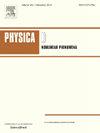动力系统分支链的同步
IF 2.7
3区 数学
Q1 MATHEMATICS, APPLIED
引用次数: 0
摘要
我们研究了在单亲家庭树中组织的耦合混沌映射链中的同步动力学,考虑到每个父节点连接到两个子节点,其中一个也作为后续节点的父节点,可以捕获其属性。我们的分析侧重于两种不同的同步行为:父子同步(由链上连续节点之间的消失距离定义)和兄弟同步(对应于两个子节点状态的收敛)。我们的研究结果揭示了这两种同步机制的显著差异,这与父节点状态的概率分布密切相关。理论分析和逻辑图模拟支持我们的发现。我们进一步研究了数值方面的实施对应的情况下,模拟制度不同于理论预测一个由于计算有限的精度。我们对不稳定性如何在数值上被抑制或放大进行了详细的研究。在某些情况下,适当调整计算方案可以解决这个问题。本文章由计算机程序翻译,如有差异,请以英文原文为准。
Synchronization of branching chain of dynamical systems
We investigate the synchronization dynamics in a chain of coupled chaotic maps organized in a single-parent family tree, whose properties can be captured considering each parent node connected to two children, one of which also serves as the parent for the subsequent node. Our analysis focuses on two distinct synchronization behaviors: parent–child synchronization, defined by the vanishing distance between successive nodes along the chain, and sibling synchronization, corresponding to the convergence of the states of two child nodes. Our findings reveal significant differences in these two type of synchronization mechanisms, which are closely associated with the probability distribution of the state of parent node. Theoretical analysis and simulations with the logistic map support our findings. We further investigate numerical aspects of the implementation corresponding to cases for which the simulated regimes differ from the theoretically predicted one due to computational finite accuracy. We perform a detailed study on how instabilities are numerically suppressed or amplified along the chain. In some cases, a properly adjusted computational scheme can solve this problem.
求助全文
通过发布文献求助,成功后即可免费获取论文全文。
去求助
来源期刊

Physica D: Nonlinear Phenomena
物理-物理:数学物理
CiteScore
7.30
自引率
7.50%
发文量
213
审稿时长
65 days
期刊介绍:
Physica D (Nonlinear Phenomena) publishes research and review articles reporting on experimental and theoretical works, techniques and ideas that advance the understanding of nonlinear phenomena. Topics encompass wave motion in physical, chemical and biological systems; physical or biological phenomena governed by nonlinear field equations, including hydrodynamics and turbulence; pattern formation and cooperative phenomena; instability, bifurcations, chaos, and space-time disorder; integrable/Hamiltonian systems; asymptotic analysis and, more generally, mathematical methods for nonlinear systems.
 求助内容:
求助内容: 应助结果提醒方式:
应助结果提醒方式:


